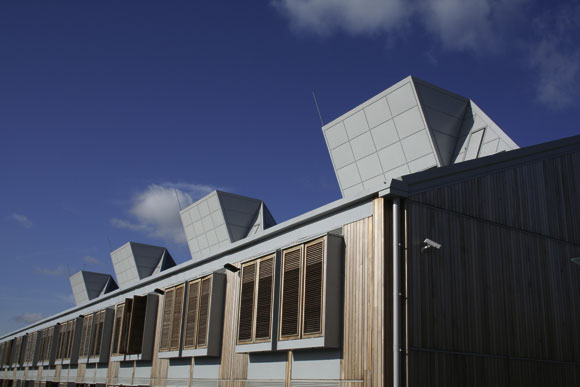Technical
Structural steel reuse
Following on from last month’s NSC article on Steel and the circular economy, Michael Sansom of the SCI focuses on structural steel reuse and in particular, the work of SCI to explore the viability of more mainstream steel reuse.
Structural steel sections are inherently reusable. Reuse, as opposed to the current, common practice of recycling steel by remelting, makes good environmental sense; saving both resources and carbon emissions. It also retains more economic activity within the UK since currently around 70% of steel scrap is exported for recycling.
SCI, working together with the University of Cambridge, has recently completed two national, (Innovate UK) projects exploring the barriers to more mainstream reuse, the economics of reuse and assessing the feasibility of developing a website for trading and sharing information about reclaimed structural steel. SCI is also working on two large European projects REDUCE and PROGRESS. This article describes these projects.
Reusing reclaimed steel is not a new idea; in fact, the practice was more prevalent in the past but has declined over the last few decades. The main reasons being new development programme constraints and tougher health and safety requirements in relation to demolition activities, in particular, working at height.
There are many steel-based temporary work systems which are highly reused; the challenge is to develop permanent work systems that are similarly reusable.
Reuse is commercially and technically viable, as demonstrated by isolated projects and in certain niche markets. Reusing simple structures, such as portal frames, is relatively common particularly in the agricultural and industrial building sectors. The SEGRO case study is a good recent example.
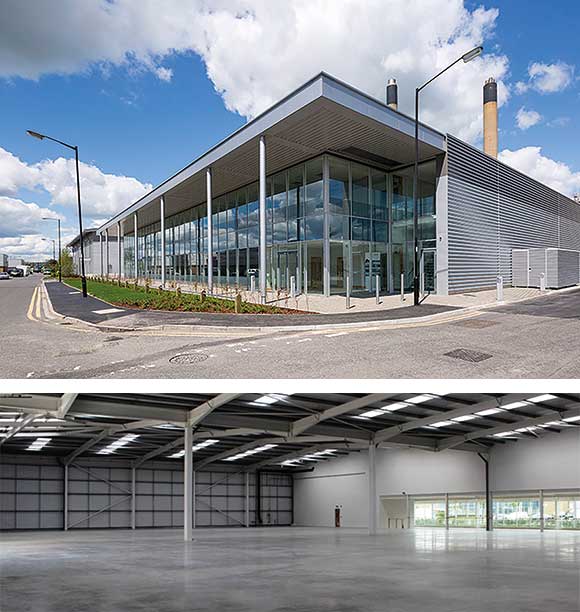
SEGRO warehouse and office building deconstructed and relocated on the Slough Trading estate in 2015
Consultations with the steel construction supply chain, confirm the technical viability but also identify the many, real and perceived, barriers to reuse. These include barriers across the supply chain, notably the additional cost and longer procurement and construction programmes involved.
Based on consultations (interviews and on-line survey) with the supply chain, the overall ranking of barriers in descending order of importance, is:
- Availability of reclaimed sections; particularly of the desired size, volume and in the right location
- Issues relating to the quality, traceability and certification of reclaimed sections
- Additional cost associated with using reclaimed sections
- (Lack of) supply chain integration; particularly communication and sharing information through the supply chain and trust (and risk sharing) between companies
- Additional time required within construction programmes to allow for using reclaimed steel; in general, additional time incurs addition cost
- Reclaiming and reusing structural steel is a relatively uncommon practice and many organisations simply do not have the skills or experience to do it
- The perception that reclaimed steel is somehow inferior to new steel sections.
![Barrier ranking by actor – the higher the score the higher the perceived importance [1]](https://www.newsteelconstruction.com/wp/wp-content/uploads/2017/04/Tech-scatterchart-1704.gif)
Barrier ranking by actor – the higher the score the higher the perceived importance [1]
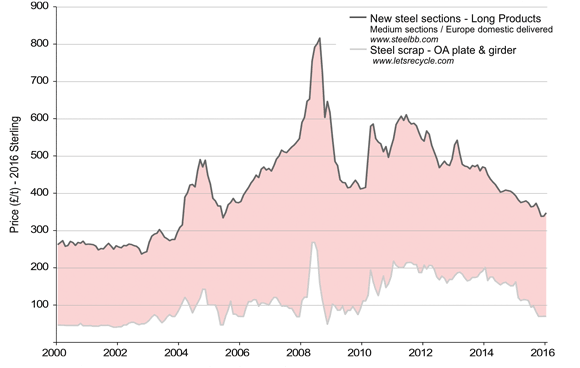
Price differential between new steel sections and scrap grade OA (2000-16) [2]
Although more mainstream structural steel reuse is unlikely under current UK economic and legislative conditions, BIM technologies overcome several of the barriers to steel reuse by providing certainty about material properties, traceability and provenance and eliminating the need for testing. Looking ahead therefore, structural steel (BIM) models offer a cost-effective means of enabling future reuse.
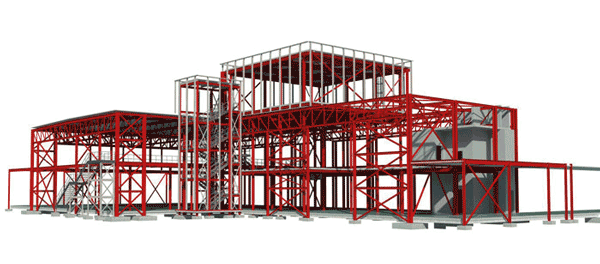 Steelwork contractors have been using BIM models for years and routinely offer their clients as-built structural models on building handover. By storing such models in a secure database, this will future-proof UK steel structures by enabling:
Steelwork contractors have been using BIM models for years and routinely offer their clients as-built structural models on building handover. By storing such models in a secure database, this will future-proof UK steel structures by enabling:
- efficient refurbishment and structural extension of existing structures
- safe deconstruction
- a detailed inventory of reclaimed steel sections for future use (with full traceability and all relevant material properties)
- optimising the recycling process through knowledge of the metallurgy of the steel.
SCI has developed a prototype website and database to facilitate trading of reclaimed steel sections and for securely storing structural steel information to enable future deconstruction and reuse.
Design for deconstruction
Design for deconstruction (and reuse) is central to the circular economy. Current practice, is generally to demolish buildings with little thought about preserving the integrity and value of components for reuse. Only by designing buildings for deconstruction can we make reuse of buildings and building components more commonplace and commercially viable.
The ability to reuse building components is, to a large extent, dependent on how buildings have been constructed in the first place. Although designers routinely consider the constructability of buildings, generally little thought is given to their deconstruction and how elements and components could be reclaimed and reused. At its simplest level, there are two main considerations:
- The types of materials and components used; some products, like structural steel, are inherently more reusable than other structural materials and systems
- The way the materials and components are put together (thus able to be taken apart) and deconstructed.
Key principles to follow in design for deconstruction are:
- Simplicity – design building systems and interfaces that are simple to understand, with a limited number of different material types and component sizes
- Standardisation and regularity – design building systems and materials that are similar throughout the building and laid out in regular, repeating patterns. Where possible, standardise elements
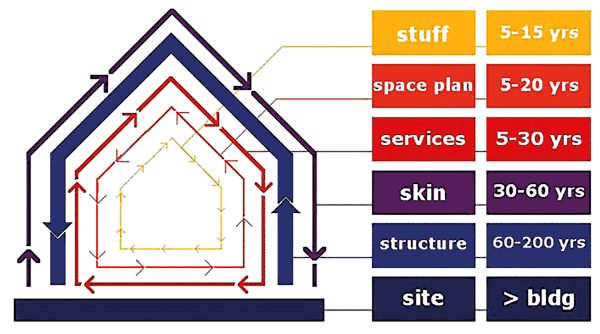
Layering approach to design for deconstruction in which different layers (with different lifetimes) are separated to facilitate deconstruction and minimise waste © SEDA
- Simplify and separate building systems – use a ‘layering approach’ to keep elements of the building (with different anticipated lifetimes) separate
- Minimise the number of different types of materials and components; fewer larger elements which are more durable and easier and quicker to remove are more likely to be reused
- Use lightweight materials and components
- Use reusable materials: chose materials that are inherently durable and reusable and retain their value through reuse
- Identify points of disassembly/connections and ensure they remain accessible
- Simplify and standardise connection details: This allows for efficient construction and deconstruction and facilitates reuse without modification after deconstruction
- Use mechanical fasteners in preference to chemicals such as sealants and adhesives
- Record as-built conditions, i.e. what was built not just what was designed
- Provide a deconstruction plan outlining general concepts where the load path for the self-weight of structure and deconstruction loads follow conventional paths. Provide specific detailed plans where load paths are not conventional. All load transfer systems should be identified
- Record adaptations to the building over its life
- Ensure information is securely stored and remains accessible.
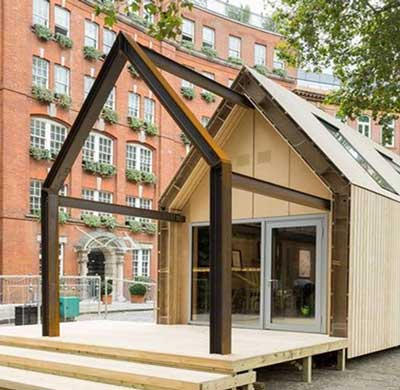
The Circular Building, London 2016
Specifically in relation to structural steel:
- Provide clear documentation of all steel members used in the structure including, size, grade, length, and connection details
- Keep records of the steel supplied, specifically mill test certificates including manufacturer, production date and standard
- Ideally steel members should have a permanent marking or tagging to assist in traceability and to identify their chemical and mechanical properties.
SCI is coordinating a collaborative EU-funded project called REDUCE (Reuse and Demountability using Steel Structures and the Circular Economy).
The overall objective of this three-year project is to provide practical tools and steel-based technologies to be able to design steel and composite structures for deconstruction and reuse. A specific objective is to develop and test composite, steel-based flooring systems which are demountable and the components reusable.
The project will investigate applications of the developed systems in commercial and residential buildings and will explore options for greater standardisation. In the context of demountable composite construction systems, the shear connector systems with the greatest potential will be tested and analysed using numerical modelling so that design guidance can be developed following the principles of Eurocode 4.
In addition, REDUCE will review methodologies to quantify the benefits of demountable buildings and reuse including life cycle assessment methodologies, e.g. CEN TC350 standards and developing metrics for quantifying circularity, e.g. those developed by the Ellen MacArthur Foundation. The project will also explore how BIM can be used to provide information to enable the building to be easily adapted during use, and/or deconstructed and the components reused at end-of-life.
SCI is also a partner in a new EU project (PROGRESS). The focus of PROGRESS is the deconstruction and reuse of elements of single-storey buildings. The project will address both the structural and envelope elements and their interfaces, and will also consider both the reuse of existing buildings and how new single-storey buildings can be designed and constructed to facilitate future reuse.
Structural steel is uniquely placed to deliver buildings that are flexible, adaptable and ultimately reusable. Although current UK commercial and legislative conditions are not conducive to more widespread reuse, the realisation that current, global consumption patterns are unsustainable leads to the conclusion that it is only a matter of time before reuse of buildings is mandatory. SCI is leading the UK steel construction sector to ensure that it is able to capitalise on these opportunities.
References
[1] Cyrille F. Dunant, Michał P. Drewniok, Michael Sansom, Simon Corbey, Julian M. Allwood, Jonathan M. Cullen (2017) Real and perceived barriers to steel reuse across the UK construction value chain, Resources, Conservation & Recycling, under review.
[2] Cyrille F. Dunant, Michał P. Drewniok, Michael Sansom, Simon Corbey, Jonathan M. Cullen, Julian M. Allwood (2017) Cost and Risk Distribution Across the Value Chain: Why Steel Reuse Is Not Profitable, Construction & Building Materials, under review.











